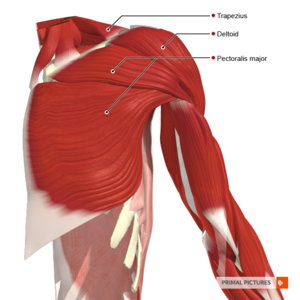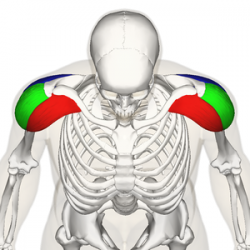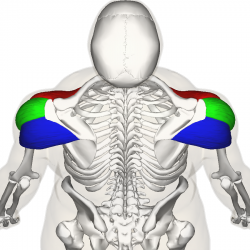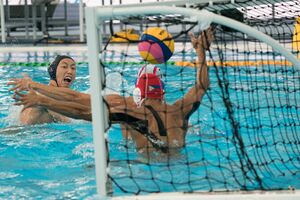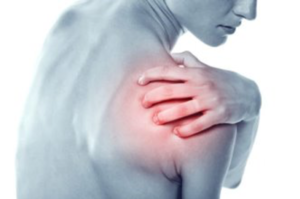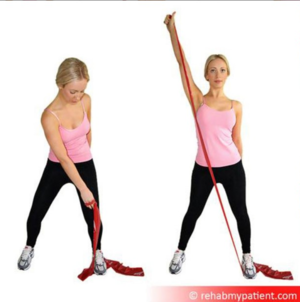Deltoid: Difference between revisions
Joao Costa (talk | contribs) No edit summary |
No edit summary |
||
| Line 6: | Line 6: | ||
== Description == | == Description == | ||
[[File:Muscles connecting the upper limb to the trunk anterior aspect Primal.png|'''Deltoid''' |alt=|right|frameless]] | [[File:Muscles connecting the upper limb to the trunk anterior aspect Primal.png|'''Deltoid''' |alt=|right|frameless]] | ||
The Deltoid muscle is a large triangular shaped muscle | The Deltoid muscle is a large triangular-shaped muscle that lies over the [[Glenohumeral Joint|glenohumeral joint]] and which gives the [[shoulder]] its rounded contour. | ||
* It is comprised of three distinct portions (anterior or clavicular, middle or acromial, and posterior or spinal) | * It is comprised of three distinct portions (anterior or clavicular, middle or acromial, and posterior or spinal) | ||
* Acts mainly as an abductor of the shoulder and stabiliser of the humeral head. as well as assists in forward elevation<ref name=":1">Moser T, Lecours J, Michaud J, Bureau NJ, Guillin R, Cardinal É. [https://pubmed.ncbi.nlm.nih.gov/23784480/ The deltoid, a forgotten muscle of the shoulder.] Skeletal radiology. 2013 Oct;42(10):1361-75.Available:https://pubmed.ncbi.nlm.nih.gov/23784480/ (accessed 5.1.2022)</ref>. | * Acts mainly as an abductor of the shoulder and stabiliser of the humeral head. as well as assists in forward elevation<ref name=":1">Moser T, Lecours J, Michaud J, Bureau NJ, Guillin R, Cardinal É. [https://pubmed.ncbi.nlm.nih.gov/23784480/ The deltoid, a forgotten muscle of the shoulder.] Skeletal radiology. 2013 Oct;42(10):1361-75.Available:https://pubmed.ncbi.nlm.nih.gov/23784480/ (accessed 5.1.2022)</ref>. | ||
* The deltoid is a very powerful muscle and is used in many [[ADLs]] (eg putting clothes | * The deltoid is a very powerful muscle and is used in many [[ADLs]] (eg putting clothes online, carrying shopping bags, washing hair) and many athletic activities. (eg netball, [[Swimming: Freestyle|swimming]], water polo).<ref>Sports MD [https://www.sportsmd.com/sports-injuries/shoulder-injuries/deltoid-strain/ Deltoid strain] Available: https://www.sportsmd.com/sports-injuries/shoulder-injuries/deltoid-strain/<nowiki/>(accessed 5.1.2021)</ref> | ||
Image 1: Deltoid Muscle overlying shoulder complex. | Image 1: Deltoid Muscle overlying shoulder complex. | ||
| Line 27: | Line 27: | ||
* [[File:Deltoid_Muscle_top9.png|alt=|right|250x250px]]Fibres from all heads converge to insert into the deltoid tuberosity on the [[humerus]]. | * [[File:Deltoid_Muscle_top9.png|alt=|right|250x250px]]Fibres from all heads converge to insert into the deltoid tuberosity on the [[humerus]]. | ||
* The deltoid [[fascia]] is continuous with the brachial fascia and connects to the medial and lateral intermuscular septa<ref>Rispoli, Damian M.; Athwal, George S.; Sperling, John W.; Cofield, Robert H. (2009). "The anatomy of the deltoid insertion". J Shoulder Elbow Surg 18: 386–390</ref>. | * The deltoid [[fascia]] is continuous with the brachial fascia and connects to the medial and lateral intermuscular septa<ref>Rispoli, Damian M.; Athwal, George S.; Sperling, John W.; Cofield, Robert H. (2009). "The anatomy of the deltoid insertion". J Shoulder Elbow Surg 18: 386–390</ref>. | ||
=== Nerve Supply === | === Nerve Supply === | ||
| Line 35: | Line 35: | ||
=== Blood Supply === | === Blood Supply === | ||
Deltoid receives its [[blood]] supply from the posterior circumflex humeral artery. | Deltoid receives its [[blood]] supply from the posterior circumflex humeral artery. | ||
== Function == | == Function == | ||
[[File:Water polo.jpeg|right|frameless]] | [[File:Water polo.jpeg|right|frameless]] | ||
An important function of deltoid is the stabilisation of the shoulder joint preventing subluxation or even dislocation of the head of the humerus particularly when carrying a load. Deltoid is the prime mover of shoulder abduction. | An important function of the deltoid is the stabilisation of the shoulder joint preventing subluxation or even dislocation of the head of the humerus, particularly when carrying a load. Deltoid is the prime mover of shoulder abduction. | ||
[[File:Suitcase.jpeg|right|frameless]] | [[File:Suitcase.jpeg|right|frameless]] | ||
All heads of deltoid work together to produce abduction of the Shoulder Joint. It helps | All heads of the deltoid work together to produce abduction of the Shoulder Joint. It helps lift the arm front, side, and backward. Deltoid pain can affect anyone who does repetitive overhead activities eg house painters, swimmers, Waterpolo players, and pitchers. It also is active with carrying objects eg suitcases or reaching up for objects, to prevent subluxation/dislocation. | ||
The deltoid compensates for loss of strength in the rotator cuff. | The deltoid compensates for the loss of strength in the rotator cuff. | ||
Images 4 and 5: Deltoids in action in water polo; in carrying deltoid prevent subluxation of shoulder joint. | Images 4 and 5: Deltoids in action in water polo; in carrying deltoid prevent subluxation of the shoulder joint. | ||
== Clinical Relevance == | == Clinical Relevance == | ||
[[File:Shoulder Pain.png|right|frameless]] | [[File:Shoulder Pain.png|right|frameless]] | ||
| Line 51: | Line 51: | ||
* Tears are not infrequently associated with large or massive rotator cuff tears and may further jeopardize shoulder function. | * Tears are not infrequently associated with large or massive rotator cuff tears and may further jeopardize shoulder function. | ||
* Rotator cuff tears place more strain on the deltoid to prevent abduction motion loss. Fatigue or injury to the deltoid may result in a precipitous decline in abduction.<ref>Dyrna F, Kumar NS, Obopilwe E, Scheiderer B, Comer B, Nowak M, Romeo AA, Mazzocca AD, Beitzel K. [https://pubmed.ncbi.nlm.nih.gov/29741391/ Relationship between deltoid and rotator cuff muscles during dynamic shoulder abduction: a biomechanical study of rotator cuff tear progression.] The American journal of sports medicine. 2018 Jul;46(8):1919-26.Available: https://pubmed.ncbi.nlm.nih.gov/29741391/<nowiki/>(accessed 5.1.2022)</ref> | * Rotator cuff tears place more strain on the deltoid to prevent abduction motion loss. Fatigue or injury to the deltoid may result in a precipitous decline in abduction.<ref>Dyrna F, Kumar NS, Obopilwe E, Scheiderer B, Comer B, Nowak M, Romeo AA, Mazzocca AD, Beitzel K. [https://pubmed.ncbi.nlm.nih.gov/29741391/ Relationship between the deltoid and rotator cuff muscles during dynamic shoulder abduction: a biomechanical study of rotator cuff tear progression.] The American journal of sports medicine. 2018 Jul;46(8):1919-26.Available: https://pubmed.ncbi.nlm.nih.gov/29741391/<nowiki/>(accessed 5.1.2022)</ref> | ||
* A variety of other pathologies may affect the deltoid muscle including enthesitis, calcific tendinitis, myositis, infection, tumors, and chronic avulsion injury. | * A variety of other pathologies may affect the deltoid muscle including enthesitis, calcific tendinitis, myositis, infection, tumors, and chronic avulsion injury. | ||
* The deltoid muscle and its innervating axillary nerve may be injured during shoulder surgery, which may have disastrous functional consequences. | * The deltoid muscle and its innervating axillary nerve may be injured during shoulder surgery, which may have disastrous functional consequences. | ||
* Axillary neuropathies | * Axillary neuropathies lead to deltoid muscle dysfunction and cause denervation of the deltoid muscle. | ||
* Abnormalities of the deltoid may originate from nearby pathologies of subdeltoid bursa, acromion, and distal clavicle.<ref name=":1" /> | * Abnormalities of the deltoid may originate from nearby pathologies of the subdeltoid bursa, acromion, and distal clavicle.<ref name=":1" /> | ||
* During dislocation of the shoulder or fracture of surgical neck of the humerus axillary nerve may be injured. The [[Axillary Nerve Injury|damage to axillary nerve]] leads to | * During dislocation of the shoulder or fracture of surgical neck of the humerus axillary nerve may be injured. The [[Axillary Nerve Injury|damage to axillary nerve]] leads to paralysis of the deltoid muscle.<ref name=":0">Chaurasia BD. [https://www.pdfdrive.com/bd-chaurasia-books.html Human Anatomy Regional and Applied Dissection and Clinical]. Vol 1. CBS Publishers and Distributors Pvt Ltd, 2010</ref><br> | ||
== Palpation == | == Palpation == | ||
* Flex elbow to 90 degrees and have patient abduct the shoulder against resistance. | * Flex elbow to 90 degrees and have the patient abduct the shoulder against resistance. | ||
* Anterior Fibers: Deltoid palpated with elbow extended, shoulder 90 degrees abduction and then resist horizontal adduction. | * Anterior Fibers: Deltoid palpated with the elbow extended, shoulder 90 degrees abduction, and then resist horizontal adduction. | ||
* Posterior Fibers: Position same as above and then resist horizontal abduction. | * Posterior Fibers: Position same as above and then resist horizontal abduction. | ||
=== Length Tension Testing === | === Length Tension Testing === | ||
| Line 71: | Line 71: | ||
==== Length Tension Testing ==== | ==== Length Tension Testing ==== | ||
Anterior Deltoid- The position of patient will be high sitting | Anterior Deltoid- The position of the patient will be high sitting | ||
* The therapist will be standing behind the patient holding the testing shoulder | * The therapist will be standing behind the patient holding the testing shoulder | ||
* The primary function of anterior deltoid is flexion, internal rotation and horizontal adduction, to stretch this muscle, reverse the action by extension, external rotation and horizontal abduction shoulder, without letting the torso rotate | * The primary function of the anterior deltoid is flexion, internal rotation, and horizontal adduction, to stretch this muscle, reverse the action by extension, external rotation, and horizontal abduction shoulder, without letting the torso rotate | ||
* While performing extension and external rotation, place your one hand on the patient forearm and with the other hand push the shoulder anteriorly from posterior, thereby lengthening the muscle | * While performing extension and external rotation, place your one hand on the patient forearm and with the other hand push the shoulder anteriorly from posterior, thereby lengthening the muscle | ||
Posterior Deltoid- The position of patient will be high sitting | Posterior Deltoid- The position of the patient will be high sitting | ||
* The therapist will be standing in front of the patient initially and moving back to the patient later for better length assessment | * The therapist will be standing in front of the patient initially and moving back to the patient later for a better length assessment | ||
* The primary function of posterior deltoid is extension, external rotation and horizontal abduction, to stretch this muscle, reverse the action by flexion, internal rotation and horizontal adduction shoulder joint. | * The primary function of the posterior deltoid is extension, external rotation, and horizontal abduction, to stretch this muscle, reverse the action by flexion, internal rotation, and horizontal adduction shoulder joint. | ||
* While performing flexion, internal rotation and horizontal adduction, place | * While performing flexion, internal rotation, and horizontal adduction, place one hand on the patient's shoulder and the other hand on the patient's forearm | ||
* Alternatively, perform flexion, internal rotation and horizontal adduction shoulder by bringing the patient's shoulder against the chest and therapist moving to the back of the patient by holding the patient's shoulder and forearm, lengthening the muscle. | * Alternatively, perform flexion, internal rotation, and horizontal adduction shoulder by bringing the patient's shoulder against the chest and the therapist moving to the back of the patient by holding the patient's shoulder and forearm, lengthening the muscle. | ||
== Exercises == | == Exercises == | ||
[[File:Shoulder Diagonal PNF with band.png|right|frameless]] | [[File: Shoulder Diagonal PNF with band.png|right|frameless]] | ||
The following deltoid strengthening exercises are designed to improve the strength of the deltoid muscles | The following deltoid strengthening exercises are designed to improve the strength of the deltoid muscles | ||
Isometric Deltoid Contraction | Isometric Deltoid Contraction | ||
* Standing next to a wall with back and elbow straight. Gently push arm to the side against the wall as hard as possible and | * Standing next to a wall with back and elbow straight. Gently push the arm to the side against the wall as hard as possible and comfortably without pain. Hold for 5 seconds and repeat 10 times on each side provided it is pain-free.<ref>Shoulderdoc.co.uk. Available from:https://www.shoulderdoc.co.uk/article/1028 (accessed 10 Nov 2020). </ref> | ||
Progress | Progress | ||
* Suitable dumbbell weight, arm raises anterior, lateral and posterior. Repeat 10 times on each side provided it is pain free | * Suitable dumbbell weight, arm raises anterior, lateral, and posterior. Repeat 10 times on each side provided it is pain-free | ||
* Resistance Band Forward Raises, lateral raises and | * Resistance Band Forward Raises, lateral raises, and pullbacks. Repeat 10 times on each side provided it is pain free<ref>Physio advisor [https://www.physioadvisor.com.au/exercises/strengthening-muscles/deltoid-shoulders/ Deltoid Strengthening Exercises] Available: https://www.physioadvisor.com.au/exercises/strengthening-muscles/deltoid-shoulders/<nowiki/>(accessed 6.1.2022)</ref> | ||
Further progress | Further progress | ||
* Lots of variations eg Shoulder Diagonal PNF with band; [[Compound Exercises|compound exercises]] eg forward arm raises with squats; high side [[Plank exercise|plank]] walking. | * Lots of variations. eg Shoulder Diagonal PNF with a band; [[Compound Exercises|compound exercises]] eg forward arm raises with squats; high side [[Plank exercise|plank]] walking. | ||
Image: Shoulder Diagonal PNF with band. | Image: Shoulder Diagonal PNF with a band. | ||
== Viewing == | == Viewing == | ||
This | This 10 minutes video on anatomy is worth watching | ||
< | {{#ev:youtube|RaIt79pPfgE|400}}<ref>AnatomyZone. Rotator Cuff | 3D Anatomy Tutorial. Available from: https://www.youtube.com/watch?v=RaIt79pPfgE [last accessed 6/6/2022]</ref> | ||
== References == | == References == | ||
Revision as of 12:32, 6 June 2022
Original Editor - Wendy Walker
Lead Editors - Lucinda hampton, Sai Kripa, Wendy Walker, Naomi O'Reilly, Joao Costa, Chrysolite Jyothi Kommu, Andeela Hafeez, Kim Jackson, Vidya Acharya, WikiSysop, Wanda van Niekerk, Aminat Abolade, Admin, Evan Thomas, George Prudden and Uchechukwu Chukwuemeka
Description[edit | edit source]
The Deltoid muscle is a large triangular-shaped muscle that lies over the glenohumeral joint and which gives the shoulder its rounded contour.
- It is comprised of three distinct portions (anterior or clavicular, middle or acromial, and posterior or spinal)
- Acts mainly as an abductor of the shoulder and stabiliser of the humeral head. as well as assists in forward elevation[1].
- The deltoid is a very powerful muscle and is used in many ADLs (eg putting clothes online, carrying shopping bags, washing hair) and many athletic activities. (eg netball, swimming, water polo).[2]
Image 1: Deltoid Muscle overlying shoulder complex.
Video: This video covers the anatomy of the deltoid in great detail [3]
Anatomy[edit | edit source]
Origin[edit | edit source]
- Anterior Fibres/Head: Lateral third, Anterior Surface of the Clavicle (close to the lateral fibres of pectoralis major).
- Mid/Lateral Head: Acromion Process scapula, Superior Surface.
- Posterior Head: Spine of the Scapula, Posterior Border.
Insertion[edit | edit source]
- Fibres from all heads converge to insert into the deltoid tuberosity on the humerus.
- The deltoid fascia is continuous with the brachial fascia and connects to the medial and lateral intermuscular septa[4].
Nerve Supply[edit | edit source]
Axillary Nerve, C5 & 6, posterior cord of the brachial plexus.
Blood Supply[edit | edit source]
Deltoid receives its blood supply from the posterior circumflex humeral artery.
Function[edit | edit source]
An important function of the deltoid is the stabilisation of the shoulder joint preventing subluxation or even dislocation of the head of the humerus, particularly when carrying a load. Deltoid is the prime mover of shoulder abduction.
All heads of the deltoid work together to produce abduction of the Shoulder Joint. It helps lift the arm front, side, and backward. Deltoid pain can affect anyone who does repetitive overhead activities eg house painters, swimmers, Waterpolo players, and pitchers. It also is active with carrying objects eg suitcases or reaching up for objects, to prevent subluxation/dislocation.
The deltoid compensates for the loss of strength in the rotator cuff.
Images 4 and 5: Deltoids in action in water polo; in carrying deltoid prevent subluxation of the shoulder joint.
Clinical Relevance[edit | edit source]
Deltoid pathologies can lead to functional disfunction of the shoulder complex
- Tears are not infrequently associated with large or massive rotator cuff tears and may further jeopardize shoulder function.
- Rotator cuff tears place more strain on the deltoid to prevent abduction motion loss. Fatigue or injury to the deltoid may result in a precipitous decline in abduction.[5]
- A variety of other pathologies may affect the deltoid muscle including enthesitis, calcific tendinitis, myositis, infection, tumors, and chronic avulsion injury.
- The deltoid muscle and its innervating axillary nerve may be injured during shoulder surgery, which may have disastrous functional consequences.
- Axillary neuropathies lead to deltoid muscle dysfunction and cause denervation of the deltoid muscle.
- Abnormalities of the deltoid may originate from nearby pathologies of the subdeltoid bursa, acromion, and distal clavicle.[1]
- During dislocation of the shoulder or fracture of surgical neck of the humerus axillary nerve may be injured. The damage to axillary nerve leads to paralysis of the deltoid muscle.[6]
Palpation[edit | edit source]
- Flex elbow to 90 degrees and have the patient abduct the shoulder against resistance.
- Anterior Fibers: Deltoid palpated with the elbow extended, shoulder 90 degrees abduction, and then resist horizontal adduction.
- Posterior Fibers: Position same as above and then resist horizontal abduction.
Length Tension Testing[edit | edit source]
Length Tension Testing[edit | edit source]
Anterior Deltoid- The position of the patient will be high sitting
- The therapist will be standing behind the patient holding the testing shoulder
- The primary function of the anterior deltoid is flexion, internal rotation, and horizontal adduction, to stretch this muscle, reverse the action by extension, external rotation, and horizontal abduction shoulder, without letting the torso rotate
- While performing extension and external rotation, place your one hand on the patient forearm and with the other hand push the shoulder anteriorly from posterior, thereby lengthening the muscle
Posterior Deltoid- The position of the patient will be high sitting
- The therapist will be standing in front of the patient initially and moving back to the patient later for a better length assessment
- The primary function of the posterior deltoid is extension, external rotation, and horizontal abduction, to stretch this muscle, reverse the action by flexion, internal rotation, and horizontal adduction shoulder joint.
- While performing flexion, internal rotation, and horizontal adduction, place one hand on the patient's shoulder and the other hand on the patient's forearm
- Alternatively, perform flexion, internal rotation, and horizontal adduction shoulder by bringing the patient's shoulder against the chest and the therapist moving to the back of the patient by holding the patient's shoulder and forearm, lengthening the muscle.
Exercises[edit | edit source]
The following deltoid strengthening exercises are designed to improve the strength of the deltoid muscles
Isometric Deltoid Contraction
- Standing next to a wall with back and elbow straight. Gently push the arm to the side against the wall as hard as possible and comfortably without pain. Hold for 5 seconds and repeat 10 times on each side provided it is pain-free.[7]
Progress
- Suitable dumbbell weight, arm raises anterior, lateral, and posterior. Repeat 10 times on each side provided it is pain-free
- Resistance Band Forward Raises, lateral raises, and pullbacks. Repeat 10 times on each side provided it is pain free[8]
Further progress
- Lots of variations. eg Shoulder Diagonal PNF with a band; compound exercises eg forward arm raises with squats; high side plank walking.
Image: Shoulder Diagonal PNF with a band.
Viewing[edit | edit source]
This 10 minutes video on anatomy is worth watching
References[edit | edit source]
- ↑ 1.0 1.1 Moser T, Lecours J, Michaud J, Bureau NJ, Guillin R, Cardinal É. The deltoid, a forgotten muscle of the shoulder. Skeletal radiology. 2013 Oct;42(10):1361-75.Available:https://pubmed.ncbi.nlm.nih.gov/23784480/ (accessed 5.1.2022)
- ↑ Sports MD Deltoid strain Available: https://www.sportsmd.com/sports-injuries/shoulder-injuries/deltoid-strain/(accessed 5.1.2021)
- ↑ Deltoid muscle video - © Kenhub https://www.kenhub.com/en/library/anatomy/the-deltoid-muscle
- ↑ Rispoli, Damian M.; Athwal, George S.; Sperling, John W.; Cofield, Robert H. (2009). "The anatomy of the deltoid insertion". J Shoulder Elbow Surg 18: 386–390
- ↑ Dyrna F, Kumar NS, Obopilwe E, Scheiderer B, Comer B, Nowak M, Romeo AA, Mazzocca AD, Beitzel K. Relationship between the deltoid and rotator cuff muscles during dynamic shoulder abduction: a biomechanical study of rotator cuff tear progression. The American journal of sports medicine. 2018 Jul;46(8):1919-26.Available: https://pubmed.ncbi.nlm.nih.gov/29741391/(accessed 5.1.2022)
- ↑ Chaurasia BD. Human Anatomy Regional and Applied Dissection and Clinical. Vol 1. CBS Publishers and Distributors Pvt Ltd, 2010
- ↑ Shoulderdoc.co.uk. Available from:https://www.shoulderdoc.co.uk/article/1028 (accessed 10 Nov 2020).
- ↑ Physio advisor Deltoid Strengthening Exercises Available: https://www.physioadvisor.com.au/exercises/strengthening-muscles/deltoid-shoulders/(accessed 6.1.2022)
- ↑ AnatomyZone. Rotator Cuff | 3D Anatomy Tutorial. Available from: https://www.youtube.com/watch?v=RaIt79pPfgE [last accessed 6/6/2022]
